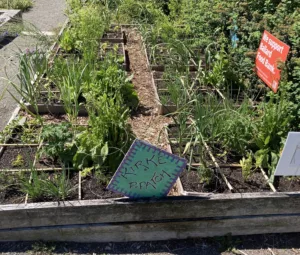It’s not a huge surprise that Diane O’Neill was the first person to go through the Square Foot Gardening Foundation’s new Certified Instructor course— and complete her certification! This Seattle, WA, (Hardiness Zone 8a) resident is full of energy, focus, and determination. Did we also mention that she’s also a retired CPA and a Zumba instructor?
“I got Mel Bartholomew’s very first book about Square Foot Gardening,” she says, “and I’ve been doing it ever since! I love that it’s so fun, requires less work, and that harvesting is so much easier.” These days, Diane and her husband, Michael, are the leaders of the Giving Garden P-Patch in Seattle— and understanding what that means requires a little history lesson. The term “P-Patch” is unique to the Seattle, Washington, area and refers to the Picardo family, on whose property the area’s first community garden was created back in the 1970s. The Picardos first leased part of their small farm property for the community garden, then sold it to the city of Seattle—and the P-Patch Program was officially born. By 1993 this program was the country’s largest community gardening program, and today, it oversees nearly 90 P-Patches around the city.
 Diane gardens at the P-Patch located within Kirke Park, which consists of four city lots acquired from an old church (kirke means “church” in Norwegian). There’s a park and playground in one part of the park, and the P-Patch in another—and within the P-Patch is the Giving Garden, which is 100 percent Square Foot Gardening. Not surprisingly, Diane reports that some of the other gardeners in the P-Patch have donated parts of their plots to be used in the Giving Garden, evidence of Diane’s infectious enthusiasm and passion for growing food not only in the SFG Method, but also for donating to an area food bank.
Diane gardens at the P-Patch located within Kirke Park, which consists of four city lots acquired from an old church (kirke means “church” in Norwegian). There’s a park and playground in one part of the park, and the P-Patch in another—and within the P-Patch is the Giving Garden, which is 100 percent Square Foot Gardening. Not surprisingly, Diane reports that some of the other gardeners in the P-Patch have donated parts of their plots to be used in the Giving Garden, evidence of Diane’s infectious enthusiasm and passion for growing food not only in the SFG Method, but also for donating to an area food bank.
“The Giving Garden has eight SFG beds, made possible by a grant from the SFG Foundation,” Diane explains, “and this year we grew five times the amount of food we grew last year!” Diane asked the food bank what kinds of food they would love to have more of, and interestingly, they reported back: fresh herbs. So Diane and her crew of volunteers got busy planting and growing chives, garlic, rosemary, sage, oregano, and basil.
“We also use a compost called Zoo Doo,” she says. “It’s composted animal manure from our local zoo, and it’s so popular that the zoo developed a lottery system to determine who gets it.” Knowing how difficult it is to obtain Zoo Doo, Diane instead simply asked the zoo for a donation—and she received an entire truckload, ready to be incorporated into Mel’s Mix™!
Lesson #1: If you don’t ask, you don’t get.
Diane says that although COVID-19 has affected how they do things at the P-Patch, they’ve simply adjusted to accommodate social distancing, which is easier since all the activities are outside. She has a great group of volunteers who plant, weed, water, harvest, and deliver all the produce to the food bank, as well deliver as a number of donations for supplies and materials from various community businesses.
Lesson #2: Focus on collaborative efforts in a large program like this one.
Once Diane starts talking about SFGing, she readily shares a number of tips ranging from where she gets supplies to how she lines her beds to which new plants she’s trying right now. Conversation with Diane sounds something like this: “Oh, you have to try . . .” or, “You are going to love . . .” and, “Do you have a source for XYZ? Oh, I’ve got a place for you. . . .” “The Greenhouse Megastore is where we order our coarse vermiculite,” she says excitedly. “If you order more than two of the 4-cubic-foot bags, you’ll get a volume discount, and if you order more than $100 of material, your shipping is free!” This is exactly the kind of tip that Mel himself would love—where to buy the best material and save money in the process. She also lines the bottoms of her SFG beds with cardboard rather than weed barrier fabric—readily available, inexpensive, and effective.
Lesson #3: Experiment to learn what works best in your SFG—it’s how Mel himself created SFG in the very beginning and evolved it over the years.
“And I believe success breeds success,” Diane states. “When you try SFGing and you see how much of a difference it can make, how successful your garden is, you just want to keep going and doing more. ” To that end, she is growing two new foods this year that she’s very excited about—French sorrel and celery leaf. She adds the lemony-tasting French sorrel to her salad greens and uses the celery leaf both in soups and salads.
Passion, energy, and resourcefulness—these are qualities that Diane O’Neill has in spades, and they’re what make her such an effective SFG practitioner and now, Certified Instructor.
Welcome to the SFG CI family, Diane—we can’t wait to see what you do next!
